
- (Re) Introduction to Tensorflow Natural Language Processing
- Abstract
- Dataset
- Experiments
- Model 0: Naive Bayes tf-ids
- Model 1: Simple Dense
- Model 2: LSTM Long-term Short-term Memory RNN
- Model 3: GRU Gated Recurrent Unit RNN
- Model 4: Bi-Directional RNN
- Model 5: Conv1D
- Model 6: Transfer Learning Feature Extractor
- Model 6a (added Dense Layer)
- Model 6b: Transfer Learning Feature Extractor (10% Dataset)
- Model 6c: USE Data Leakage Issue (10% Dataset)
- Compare Experiments
- Saving & Loading Trained Model
- Best Model Evaluation
- Test Dataset Predictions
- Speed/Score Tradeoff
(Re) Introduction to Tensorflow Natural Language Processing
Abstract
Twitter has become an important communication channel in times of emergency. The ubiquitousness of smartphones enables people to announce an emergency they’re observing in real-time. Because of this, more agencies are interested in programatically monitoring Twitter (i.e. disaster relief organizations and news agencies).
But, it’s not always clear whether a person’s words are actually announcing a disaster. Here Machine Learning can help us segmenting large quantities of incoming messages. But what type Machine Learning is the best suited?
I am running a couple of experiments to show the performace of different solutions and their trade-off - how long does it take to get a prediction from a given algorithm? Is a higher accuracy worth the wait?
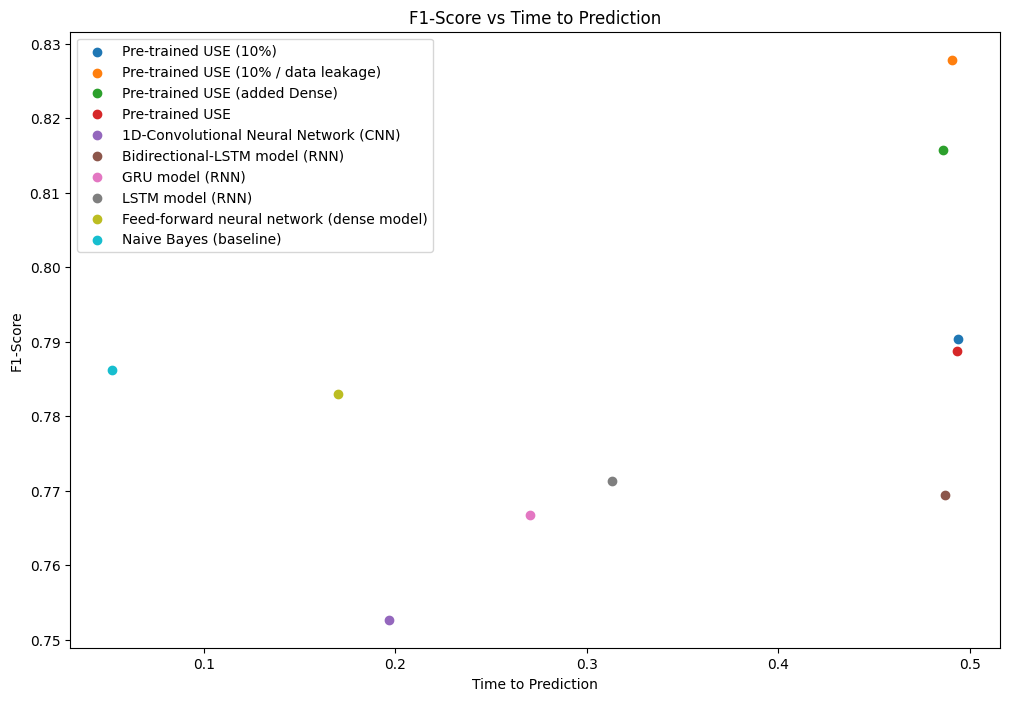
Dataset
https://www.kaggle.com/competitions/nlp-getting-started/data
.
├── data
│ ├── test.csv
│ └── train.csv
import datetime
import io
import matplotlib.pyplot as plt
import numpy as np
import pandas as pd
import random
import time
from sklearn.model_selection import train_test_split
from sklearn.feature_extraction.text import TfidfVectorizer
from sklearn.naive_bayes import MultinomialNB
from sklearn.pipeline import Pipeline
import tensorflow as tf
# tf-hub bug https://stackoverflow.com/questions/69339917/importerror-cannot-import-name-dnn-logit-fn-builder-from-partially-initialize
from tensorflow_estimator.python.estimator.canned.dnn import dnn_logit_fn_builder
import tensorflow_hub as hub
from tensorflow.keras.layers import (
TextVectorization,
Embedding,
Input,
Dense,
GlobalAveragePooling1D,
GlobalMaxPool1D,
LSTM,
GRU,
Bidirectional,
Conv1D
)
from helper_functions import (
create_tensorboard_callback,
plot_loss_curves,
compare_histories,
calculate_metrics,
time_to_prediction
)
SEED = 42
LOG_DIR = 'tensorboad'
Exploration
train_df = pd.read_csv('data/train.csv')
test_df = pd.read_csv('data/test.csv')
train_df.head(5)
# target 1 = disaster / 0 = not a disaster
| id | keyword | location | text | target | |
|---|---|---|---|---|---|
| 0 | 1 | NaN | NaN | Our Deeds are the Reason of this #earthquake M... | 1 |
| 1 | 4 | NaN | NaN | Forest fire near La Ronge Sask. Canada | 1 |
| 2 | 5 | NaN | NaN | All residents asked to 'shelter in place' are ... | 1 |
| 3 | 6 | NaN | NaN | 13,000 people receive #wildfires evacuation or... | 1 |
| 4 | 7 | NaN | NaN | Just got sent this photo from Ruby #Alaska as ... | 1 |
# checking if the dataset is balanced
print(train_df.target.value_counts())
# 0 4342
# 1 3271
print(len(train_df), len(test_df))
# 7613 3263
train_df_shuffle = train_df.sample(frac=1, random_state=SEED)
train_df_shuffle.head(5)
| id | keyword | location | text | target | |
|---|---|---|---|---|---|
| 2644 | 3796 | destruction | NaN | So you have a new weapon that can cause un-ima... | 1 |
| 2227 | 3185 | deluge | NaN | The f$&@ing things I do for #GISHWHES Just... | 0 |
| 5448 | 7769 | police | UK | DT @georgegalloway: RT @Galloway4Mayor: ÛÏThe... | 1 |
| 132 | 191 | aftershock | NaN | Aftershock back to school kick off was great. ... | 0 |
| 6845 | 9810 | trauma | Montgomery County, MD | in response to trauma Children of Addicts deve... | 0 |
random_index = random.randint(0, len(train_df)-5)
for row in train_df_shuffle[['text', 'target']][random_index:random_index+5].itertuples():
_, text, target = row
print(f"Target: {target}","(disaster)" if target>0 else "(not a disaster)")
print(f"Text: {text}\n")
print("---\n")
Target: 1 (disaster)
Text: @WesleyLowery ?????? how are you going to survive this devastation?
---
Target: 0 (not a disaster)
Text: Hollywood movie about trapped miners released in Chile http://t.co/xe0EE1Fzfh
---
Target: 0 (not a disaster)
Text: #sing #tsunami Beginners #computer tutorial.: http://t.co/ukQYbhxMQI Everyone Wants To Learn To Build A Pc. Re http://t.co/iDWS2ZgYsa
---
Target: 1 (disaster)
Text: #Reddit updates #content #policy promises to quarantine Û÷extremely offensiveÛª communities http://t.co/EHGtZhKAn4
---
Target: 1 (disaster)
Text: Japan Marks 70th Anniversary of Hiroshima Atomic Bombing http://t.co/cQLM9jOJOP
---
Train Test Split
train_tweets, val_tweets, train_labels, val_labels = train_test_split(
train_df_shuffle['text'].to_numpy(),
train_df_shuffle['target'].to_numpy(),
test_size=0.1,
random_state=SEED)
print(len(train_tweets), len(val_tweets))
# 6851 762
Tokenization and Embedding
Machine learning models take vectors (arrays of numbers) as input. When working with text, the first thing you must do is come up with a strategy to convert strings to numbers (or to "vectorize" the text) before feeding it to the model.
Tokenization
TextVectorization layer is a Keras layer to standardize, tokenize, and vectorize the dataset.
# find average number of words in tweets
average_tokens_per_tweet=round(sum([len(i.split()) for i in train_tweets])/len(train_tweets))
print(average_tokens_per_tweet)
# 15
# create text vectorizer
max_features = 10000 # limit to most common words
sequence_length = 15 # limit to average number of words in tweets
text_vectorizer = TextVectorization(
max_tokens=max_features, # set a value to only include most common words
standardize='lower_and_strip_punctuation',
split='whitespace',
ngrams=None, # set value to form common word groups
output_mode='int',
output_sequence_length=sequence_length, # set value to limit tweet size
pad_to_max_tokens=True # fluff tweets that are shorter than set max length
)
# fit text vectorizer to training data
text_vectorizer.adapt(train_tweets)
# test fitted vectorizer
sample_sentence1 = "Next I'm buying Coca-Cola to put the cocaine back in"
sample_sentence2 = "Hey guys, wanna feel old? I'm 40. You're welcome."
sample_sentence3 = "Beef chicken pork bacon chuck shortloin sirloin shank eu, bresaola voluptate in enim ea kielbasa laboris brisket laborum, jowl labore id porkchop elit ad commodo."
text_vectorizer([sample_sentence1,sample_sentence2,sample_sentence3])
# <tf.Tensor: shape=(3, 15), dtype=int64, numpy=
# array([[ 274, 32, 4046, 1, 5, 370, 2, 5962, 88, 4, 0,
# 0, 0, 0, 0],
# [ 706, 576, 473, 214, 206, 32, 354, 172, 1569, 0, 0,
# 0, 0, 0, 0],
# [ 1, 4013, 1, 1, 1, 1, 1, 1, 3878, 1, 1,
# 4, 1, 1, 1]])>
random_tweet = random.choice(train_tweets)
vector = text_vectorizer([random_tweet])
print(
f'Tweet: {random_tweet}\
\n\nVector: {vector}'
)
# Tweet: Ignition Knock (Detonation) Sensor ACDelco GM Original Equipment 213-4678
# Vector: [[ 888 885 580 1767 1 1671 1623 1863 1 1 1 0 0 0
# 0]]
# get unique vocabulary
words_in_vocab = text_vectorizer.get_vocabulary()
top_10_words = words_in_vocab[:10]
bottom_10_words = words_in_vocab[-10:]
print(
len(words_in_vocab),
top_10_words,
bottom_10_words
)
# 10000
# ['', '[UNK]', 'the', 'a', 'in', 'to', 'of', 'and', 'i', 'is']
# ['painthey', 'painful', 'paine', 'paging', 'pageshi', 'pages', 'paeds', 'pads', 'padres', 'paddytomlinson1']
# The [UNK] stands for unknown - meaning outside of the 10.000 tokens limit
Embedding
The now vectorize data can be used as the first layer of the classification model, feeding transformed strings into an Embedding layer. The Embedding layer takes the integer-encoded vocabulary and looks up the embedding vector for each word-index. These vectors are learned as the model trains. The vectors add a dimension to the output array.
# create embedding layer
embedding = Embedding(
input_dim = max_features,
output_dim = 128,
input_length = sequence_length
)
random_tweet = random.choice(train_tweets)
sample_embedd = embedding(text_vectorizer([random_tweet]))
print(
f'Tweet: {random_tweet}\
\n\nEmbedding: {sample_embedd}, {sample_embedd.shape}'
)
# Tweet: @biggangVH1 looks like George was having a panic attack. LOL.
# Embedding: [[[-0.02811491 -0.02710991 -0.04273632 ... 0.01480064 -0.02413664
# 0.02612327]
# [-0.013403 -0.04941868 0.03431542 ... 0.00432001 -0.03614474
# 0.04559914]
# [ 0.00161045 -0.02501463 0.02461291 ... -0.02123032 0.02596099
# -0.02626952]
# ...
# [ 0.03742747 0.03854593 -0.02052871 ... 0.01287705 -0.04228047
# -0.02316147]
# [ 0.03742747 0.03854593 -0.02052871 ... 0.01287705 -0.04228047
# -0.02316147]
# [ 0.03742747 0.03854593 -0.02052871 ... 0.01287705 -0.04228047
# -0.02316147]]], (1, 15, 128)
# the shape tells us the the layer received 1 input with the length of
# 15 words (as set before and filled up with zeros if tweet is shorter)
# and each of those words is now represented by a 128dim vector
Experiments
- Model 0: Naive Bayes (baseline)
- Model 1: Feed-forward neural network (dense model)
- Model 2: LSTM model (RNN)
- Model 3: GRU model (RNN)
- Model 4: Bidirectional-LSTM model (RNN)
- Model 5: 1D-Convolutional Neural Network (CNN)
- Model 6: TensorFlow Hub pre-trained NLP feature extractor
- Model 6a: Model 6 with added complexity (add dense layer)
- Model 6b: Model 6a with 10% training data
- Model 6c: Model 6a with 10% training data (fixed sampling)
Model 0: Naive Bayes tf-ids
Tokenization and Modelling Pipeline
model_0 = Pipeline([
("tfidf", TfidfVectorizer()),
("clf", MultinomialNB())
])
# fit to training data
model_0.fit(train_tweets, train_labels)
Evaluation
baseline_score = model_0.score(val_tweets, val_labels)
print(f"Baseline accuracy: {baseline_score*100:.2f}%")
# Baseline accuracy: 79.27%
Predictions
baseline_preds = model_0.predict(val_tweets)
print(val_tweets[:10])
print(baseline_preds[:10])
# array([1, 1, 1, 0, 0, 1, 1, 1, 1, 0])
[1 1 1 0 0 1 1 1 1 0]
- 'DFR EP016 Monthly Meltdown - On Dnbheaven 2015.08.06 http://t.co/EjKRf8N8A8 #Drum and Bass #heavy #nasty http://t.co/SPHWE6wFI5'
- 'FedEx no longer to transport bioterror germs in wake of anthrax lab mishaps http://t.co/qZQc8WWwcN via @usatoday'
- 'Gunmen kill four in El Salvador bus attack: Suspected Salvadoran gang members killed four people and wounded s... http://t.co/CNtwB6ScZj'
- '@camilacabello97 Internally and externally screaming'
- 'Radiation emergency #preparedness starts with knowing to: get inside stay inside and stay tuned http://t.co/RFFPqBAz2F via @CDCgov'
- 'Investigators rule catastrophic structural failure resulted in 2014 Virg.. Related Articles: http://t.co/Cy1LFeNyV8'
- 'How the West was burned: Thousands of wildfires ablaze in #California alone http://t.co/iCSjGZ9tE1 #climate #energy http://t.co/9FxmN0l0Bd'
- "Map: Typhoon Soudelor's predicted path as it approaches Taiwan; expected to make landfall over southern China by S\x89Û_ http://t.co/JDVSGVhlIs"
- '\x89Ûª93 blasts accused Yeda Yakub dies in Karachi of heart attack http://t.co/mfKqyxd8XG #Mumbai'
- 'My ears are bleeding https://t.co/k5KnNwugwT']
baseline_metrics = calculate_metrics(
y_true=val_labels,
y_pred=baseline_preds
)
print(f"Accuracy: {baseline_metrics['accuracy']}, Precision: {baseline_metrics['precision']}, Recall: {baseline_metrics['recall']}, F1-Score: {baseline_metrics['f1']}")
Model 0 Metrics
- Accuracy: 79.26509186351706,
- Precision: 0.8111390004213173,
- Recall: 0.7926509186351706,
- F1-Score: 0.7862189758049549
Model 1: Simple Dense
Model Building and Training
# build model
## inputs are single 1-dimensional strings
inputs = Input(shape=(1,), dtype=tf.string)
## turn strings into numbers
x = text_vectorizer(inputs)
## create embedding from vectorized input
x = embedding(x)
## instead of returning a prediction for every token/word
## condense all to a single prediction for entire input string
x = GlobalAveragePooling1D()(x)
## sigmoid activated output for binary classification
outputs = Dense(1, activation='sigmoid')(x)
model_1 = tf.keras.Model(inputs, outputs, name='model_1_dense')
model_1.summary()
Model: "model_1_dense"
_________________________________________________________________
Layer (type) Output Shape Param #
=================================================================
input_3 (InputLayer) [(None, 1)] 0
text_vectorization (TextVec (None, 15) 0
torization)
embedding (Embedding) (None, 15, 128) 1280000
global_average_pooling1d (G (None, 128) 0
lobalAveragePooling1D)
dense_2 (Dense) (None, 1) 129
=================================================================
Total params: 1,280,129
Trainable params: 1,280,129
Non-trainable params: 0
_________________________________________________________________
# compile model
model_1.compile(
loss='binary_crossentropy',
optimizer=tf.keras.optimizers.Adam(),
metrics=['accuracy']
)
# there seems to be an issue with the tb callback
# https://github.com/keras-team/keras/issues/15163
# changed histogram_freq=0
## create a callback to track experiments in TensorBoard
def create_tensorboard_callback_bugged(dir_name, experiment_name):
# log progress to log directory
log_dir = dir_name + "/" + experiment_name + "/" + datetime.datetime.now().strftime("%Y%m%d-%H%M%S")
tensorboard_callback = tf.keras.callbacks.TensorBoard(log_dir=log_dir, histogram_freq=0)
print(f"INFO :: Saving TensorBoard Log to: {log_dir}")
return tensorboard_callback
# model training
model_1_history = model_1.fit(
x=train_tweets,
y=train_labels,
epochs=5,
validation_data=(val_tweets, val_labels),
callbacks=[create_tensorboard_callback_bugged(
dir_name=LOG_DIR,
experiment_name='model_1_dense'
)]
)
Model Evaluation
model_1.evaluate(val_tweets, val_labels)
# loss: 0.4830 - accuracy: 0.7887
model_1_preds = model_1.predict(val_tweets)
sample_prediction=model_1_preds[0]
print(f"Prediction: {sample_prediction}","(disaster)" if sample_prediction>0.5 else "(not a disaster)")
# Prediction: [0.32197773] (not a disaster)
# convert model prediction probabilities to binary label format
model_1_preds = tf.squeeze(tf.round(model_1_preds))
model_1_metrics = calculate_metrics(
y_true=val_labels,
y_pred=model_1_preds
)
print(model_1_metrics)
Model 1 Metrics
- Accuracy: 78.87139107611549
- Precision: 0.7969619064252174
- Recall: 0.7887139107611548
- F1: 0.7847294282013199
# the model performs worse than the baseline model
np.array(list(model_1_metrics.values())) > np.array(list(baseline_metrics.values()))
# array([False, False, False, False])
Visualize the Embedding
# get vocab from text vectorizer layer
words_in_vocab = text_vectorizer.get_vocabulary()
top_10_words = words_in_vocab[:10]
print(top_10_words)
# ['', '[UNK]', 'the', 'a', 'in', 'to', 'of', 'and', 'i', 'is']
# get embedding weight matrix
embed_weights = model_1.get_layer('embedding').get_weights()[0]
print(embed_weights.shape)
# (10000, 128) same size as max_features - one weight for every word in vocabulary
The embeddeding weights started as random numbers assigned to each token/word in our dataset. By fitting this embedding space to our dataset these weights can now be used to group the words in our dataset. Words that belong to the same class should also have similar vectors representing them.
We can use the Tensorflow Projector to display our embedding space:
out_v = io.open('embedding_weights/vectors_model1.tsv', 'w', encoding='utf-8')
out_m = io.open('embedding_weights/metadata_model1.tsv', 'w', encoding='utf-8')
for index, word in enumerate(words_in_vocab):
if index == 0:
continue # skip padding
vec = embed_weights[index]
out_v.write('\t'.join([str(x) for x in vec]) + '\n')
out_m.write(word + '\n')
out_v.close()
out_m.close()
# Upload both files to the [Tensorflow Projector](https://projector.tensorflow.org/)
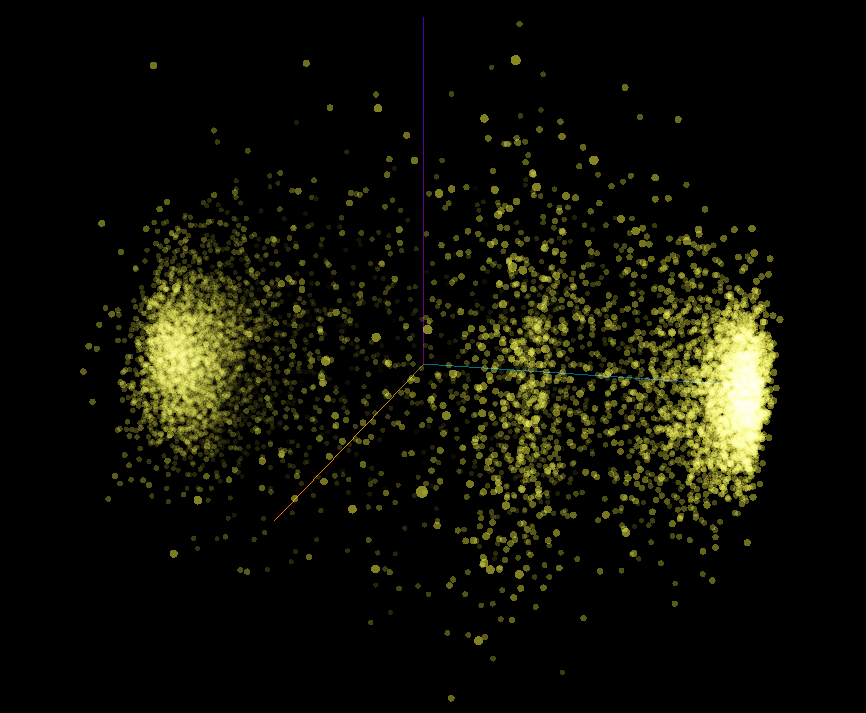
The projection shows a clear separation between our two classes showing each word in our vocabulary as a member of one of two clusters.
Model 2: LSTM Long-term Short-term Memory RNN
Model Building and Training
inputs = Input(shape=(1,), dtype='string')
x = text_vectorizer(inputs)
x = embedding(x)
# x = LSTM(64, return_sequences=True)(x)
x = LSTM(64)(x)
x = Dense(64, activation='relu')(x)
outputs = Dense(1, activation='sigmoid')(x)
model_2 = tf.keras.Model(inputs, outputs, name="model_2_LSTM")
model_2.summary()
Model: "model_2_LSTM"
_________________________________________________________________
Layer (type) Output Shape Param #
=================================================================
input_3 (InputLayer) [(None, 1)] 0
text_vectorization (TextVec (None, 15) 0
torization)
embedding (Embedding) (None, 15, 128) 1280000
lstm_2 (LSTM) (None, 64) 49408
dense_3 (Dense) (None, 64) 4160
dense_4 (Dense) (None, 1) 65
=================================================================
Total params: 1,333,633
Trainable params: 1,333,633
Non-trainable params: 0
_________________________________________________________________
model_2.compile(
loss='binary_crossentropy',
optimizer=tf.keras.optimizers.Adam(),
metrics=['accuracy']
)
model_2_history = model_2.fit(
train_tweets,
train_labels,
epochs=5,
validation_data=(val_tweets, val_labels),
callbacks=[create_tensorboard_callback_bugged(
dir_name=LOG_DIR,
experiment_name='model_2_lstm'
)]
)
Model Evaluation
model_2.evaluate(val_tweets, val_labels)
# loss: 1.6905 - accuracy: 0.7743
# make predictions
model_2_preds = model_2.predict(val_tweets)
sample_prediction=model_2_preds[0]
print(f"Prediction: {sample_prediction}","(disaster)" if sample_prediction>0.5 else "(not a disaster)")
# Prediction: [0.04310093] (not a disaster)
# convert model prediction probabilities to binary label format
model_2_preds = tf.squeeze(tf.round(model_2_preds))
model_2_metrics = calculate_metrics(
y_true=val_labels,
y_pred=model_2_preds
)
print(model_2_metrics)
Model 2 Metrics
- Accuracy: 76.77165354330708
- Precision: 0.7674723453090632
- Recall: 0.7677165354330708
- F1: 0.7668863186407149
# the model performs worse than the previous model
np.array(list(model_2_metrics.values())) > np.array(list(model_1_metrics.values()))
# array([False, False, False, False])
Model 3: GRU Gated Recurrent Unit RNN
Model Building and Training
inputs = Input(shape=(1,), dtype=tf.string)
x = text_vectorizer(inputs)
x = embedding(x)
# x = GRU(64, return_sequences=True)(x)
x = GRU(64)(x)
x = Dense(64, activation='relu')(x)
outputs = Dense(1, activation='sigmoid')(x)
model_3 = tf.keras.Model(inputs, outputs, name="model_3_GRU")
model_3.summary()
Model: "model_3_GRU"
_________________________________________________________________
Layer (type) Output Shape Param #
=================================================================
input_4 (InputLayer) [(None, 1)] 0
text_vectorization (TextVec (None, 15) 0
torization)
embedding (Embedding) (None, 15, 128) 1280000
gru (GRU) (None, 64) 37248
dense_5 (Dense) (None, 64) 4160
dense_6 (Dense) (None, 1) 65
=================================================================
Total params: 1,321,473
Trainable params: 1,321,473
Non-trainable params: 0
_________________________________________________________________
model_3.compile(
loss='binary_crossentropy',
optimizer=tf.keras.optimizers.Adam(),
metrics=['accuracy']
)
model_3_history = model_3.fit(
train_tweets,
train_labels,
epochs=5,
validation_data=(val_tweets, val_labels),
callbacks=[create_tensorboard_callback_bugged(
dir_name=LOG_DIR,
experiment_name='model_3_gru'
)]
)
Model Evaluation
model_3.evaluate(val_tweets, val_labels)
# loss: 1.2467 - accuracy: 0.7703
# make predictions
model_3_preds = model_3.predict(val_tweets)
sample_prediction=model_3_preds[0]
print(f"Prediction: {sample_prediction}","(disaster)" if sample_prediction>0.5 else "(not a disaster)")
# Prediction: [0.00013416] (not a disaster)
# convert model prediction probabilities to binary label format
model_3_preds = tf.squeeze(tf.round(model_3_preds))
model_3_metrics = calculate_metrics(
y_true=val_labels,
y_pred=model_3_preds
)
print(model_3_metrics)
Model 3 Metrics
- Accuracy: 76.9028871391076
- Precision: 0.7768747910576218
- Recall: 0.7690288713910761
- F1: 0.7643954892702002
# the model performs (sometimes) better than the lstm but still worse than the baseline model
print(np.array(list(model_3_metrics.values())) > np.array(list(model_2_metrics.values())))
# array([ True, True, True, False])
print(np.array(list(model_3_metrics.values())) > np.array(list(baseline_metrics.values())))
# array([False, False, False, False])
Model 4: Bi-Directional RNN
Model Building and Training
inputs = Input(shape=(1,), dtype=tf.string)
x = text_vectorizer(inputs)
x = embedding(x)
x = Bidirectional(LSTM(64, return_sequences=True))(x)
x = Bidirectional(GRU(64))(x)
outputs = Dense(1, activation='sigmoid')(x)
model_4 = tf.keras.Model(inputs, outputs, name='model_4_bidirectional')
model_4.summary()
Model: "model_4_bidirectional"
_________________________________________________________________
Layer (type) Output Shape Param #
=================================================================
input_6 (InputLayer) [(None, 1)] 0
text_vectorization (TextVec (None, 15) 0
torization)
embedding (Embedding) (None, 15, 128) 1280000
bidirectional_2 (Bidirectio (None, 15, 128) 98816
nal)
bidirectional_3 (Bidirectio (None, 128) 74496
nal)
dense_8 (Dense) (None, 1) 129
=================================================================
Total params: 1,453,441
Trainable params: 1,453,441
Non-trainable params: 0
_________________________________________________________________
model_4.compile(
loss='binary_crossentropy',
optimizer=tf.keras.optimizers.Adam(),
metrics=['accuracy']
)
model_4_history = model_4.fit(
train_tweets,
train_labels,
epochs=5,
validation_data=(val_tweets, val_labels),
callbacks=[create_tensorboard_callback_bugged(
dir_name=LOG_DIR,
experiment_name='model_4_bidirectional'
)]
)
Model Evaluation
model_4.evaluate(val_tweets, val_labels)
# loss: 1.7367 - accuracy: 0.7756
# make predictions
model_4_preds = model_4.predict(val_tweets)
sample_prediction=model_4_preds[0]
print(f"Prediction: {sample_prediction}","(disaster)" if sample_prediction>0.5 else "(not a disaster)")
# Prediction: [0.00025736] (not a disaster)
# convert model prediction probabilities to binary label format
model_4_preds = tf.squeeze(tf.round(model_4_preds))
model_4_metrics = calculate_metrics(
y_true=val_labels,
y_pred=model_4_preds
)
print(model_4_metrics)
Model 4 Metrics
- Accuracy: 77.55905511811024
- Precision: 0.7777490986405654
- Recall: 0.7755905511811023
- F1: 0.7733619560087615
# the model performs better than the gru but worse than the baseline model
print(np.array(list(model_4_metrics.values())) > np.array(list(model_3_metrics.values())))
# [ True True True True]
print(np.array(list(model_4_metrics.values())) > np.array(list(baseline_metrics.values())))
# [False False False False]
Model 5: Conv1D
Model Building and Training
inputs = Input(shape=(1,), dtype=tf.string)
x = text_vectorizer(inputs)
x = embedding(x)
x = Conv1D(
filters=64,
kernel_size=5, # check 5 words at a time
activation='relu',
padding='valid',
strides=1
)(x)
x = GlobalMaxPool1D()(x)
outputs = Dense(1, activation='sigmoid')(x)
model_5 = tf.keras.Model(inputs, outputs, name='model_5_conv1d')
model_5.summary()
Model: "model_5_conv1d"
_________________________________________________________________
Layer (type) Output Shape Param #
=================================================================
input_14 (InputLayer) [(None, 1)] 0
text_vectorization (TextVec (None, 15) 0
torization)
embedding (Embedding) (None, 15, 128) 1280000
conv1d_6 (Conv1D) (None, 11, 64) 41024
global_max_pooling1d_5 (Glo (None, 64) 0
balMaxPooling1D)
dense_14 (Dense) (None, 1) 65
=================================================================
Total params: 1,321,089
Trainable params: 1,321,089
Non-trainable params: 0
_________________________________________________________________
model_5.compile(
loss='binary_crossentropy',
optimizer=tf.keras.optimizers.Adam(),
metrics=['accuracy']
)
model_5_history = model_5.fit(
train_tweets,
train_labels,
epochs=5,
validation_data=(val_tweets, val_labels),
callbacks=[create_tensorboard_callback_bugged(
dir_name=LOG_DIR,
experiment_name='model_5_conv1d'
)]
)
Model Evaluation
model_5.evaluate(val_tweets, val_labels)
# loss: 1.3018 - accuracy: 0.7454
# make predictions
model_5_preds = model_5.predict(val_tweets)
sample_prediction=model_5_preds[0]
print(f"Prediction: {sample_prediction}","(disaster)" if sample_prediction>0.5 else "(not a disaster)")
# Prediction: [0.05387583] (not a disaster)
# convert model prediction probabilities to binary label format
model_5_preds = tf.squeeze(tf.round(model_5_preds))
model_5_metrics = calculate_metrics(
y_true=val_labels,
y_pred=model_5_preds
)
print(model_5_metrics)
Model 5 Metrics
- Accuracy: 74.67191601049869
- Precision: 0.7465631385096111
- Recall: 0.7467191601049868
- F1: 0.7453858813570734
# the model performs worse than the gru and worse than the baseline model
print(np.array(list(model_5_metrics.values())) > np.array(list(model_4_metrics.values())))
# [False False False False]
print(np.array(list(model_5_metrics.values())) > np.array(list(baseline_metrics.values())))
# [False False False False]
Model 6: Transfer Learning Feature Extractor
USE Feature Extractor - Universal Sentence Encoder
# https://tfhub.dev/google/collections/universal-sentence-encoder/1
embed = hub.load("https://tfhub.dev/google/universal-sentence-encoder/4")
# test the encoder
sample_sentence1 = "Next I'm buying Coca-Cola to put the cocaine back in"
sample_sentence2 = "Hey guys, wanna feel old? I'm 40. You're welcome."
sample_sentence3 = "Beef chicken pork bacon chuck shortloin sirloin shank eu, bresaola voluptate in enim ea kielbasa laboris brisket laborum, jowl labore id porkchop elit ad commodo."
embed_sample = embed([
sample_sentence1,
sample_sentence2,
sample_sentence3
])
print(embed_sample)
# the encoder turns each input into size-512 feature vectors
# [[ 0.06844153 -0.0325974 -0.01901028 ... -0.03307429 -0.04625704
# -0.08149158]
# [ 0.02810995 -0.06714624 0.02414106 ... -0.02519046 0.03197665
# 0.02462349]
# [ 0.03188843 -0.0167392 -0.03194157 ... -0.04541751 -0.05822486
# -0.07237621]], shape=(3, 512), dtype=float32)
Model Building and Training
model_6 = tf.keras.models.Sequential(name='model_6_use')
model_6.add(hub.KerasLayer(
'https://tfhub.dev/google/universal-sentence-encoder/4',
input_shape=[], # layer excepts string of variable length and returns a 512 feature vector
dtype=tf.string,
trainable=False,
name='sentence-encoder'
))
model_6.add(Dense(1, activation='sigmoid'))
model_6.summary()
Model: "model_6_use"
_________________________________________________________________
Layer (type) Output Shape Param #
=================================================================
sentence-encoder (KerasLaye (None, 512) 256797824
r)
dense_5 (Dense) (None, 1) 513
=================================================================
Total params: 256,798,337
Trainable params: 513
Non-trainable params: 256,797,824
_________________________________________________________________
model_6.compile(
loss='binary_crossentropy',
optimizer=tf.keras.optimizers.Adam(),
metrics=['accuracy']
)
model_6_history = model_6.fit(
train_tweets,
train_labels,
epochs=5,
validation_data=(val_tweets, val_labels),
callbacks=[create_tensorboard_callback_bugged(
dir_name=LOG_DIR,
experiment_name='model_6_use'
)]
)
Model Evaluation
model_6.evaluate(val_tweets, val_labels)
# loss: 0.4982 - accuracy: 0.7887
# make predictions
model_6_preds = model_6.predict(val_tweets)
sample_prediction=model_6_preds[0]
print(f"Prediction: {sample_prediction}","(disaster)" if sample_prediction>0.5 else "(not a disaster)")
# Prediction: [0.36132362] (not a disaster)
# convert model prediction probabilities to binary label format
model_6_preds = tf.squeeze(tf.round(model_6_preds))
model_6_metrics = calculate_metrics(
y_true=val_labels,
y_pred=model_6_preds
)
print(model_6_metrics)
Model 6 Metrics
- Accuracy: 78.87139107611549
- Precision: 0.7891485217486439
- Recall: 0.7887139107611548
- F1: 0.7876016937745534
# the model performs better than the conv1d and gettin close to the baseline model
print(np.array(list(model_6_metrics.values())) > np.array(list(model_5_metrics.values())))
# [ True True True True]
print(np.array(list(model_6_metrics.values())) > np.array(list(baseline_metrics.values())))
# [False False False True]
Model 6a (added Dense Layer)
The model get's close to the baseline model - I will try to add another Dense layer and see if this improves the performance.
Otherwise the model is identical - only written for functional API (no reason, just for practise :) )
inputs = Input(shape=[], dtype=tf.string)
x = hub.KerasLayer(
'https://tfhub.dev/google/universal-sentence-encoder/4',
trainable=False,
dtype=tf.string,
name='sentence-encoder'
)(inputs)
x = Dense(64, activation='relu')(x)
output = Dense(1, activation='sigmoid')(x)
model_6a = tf.keras.models.Model(inputs, output, name='model_6_use')
model_6a.summary()
Model: "model_6_use"
_________________________________________________________________
Layer (type) Output Shape Param #
=================================================================
input_6 (InputLayer) [(None,)] 0
sentence-encoder (KerasLaye (None, 512) 256797824
r)
dense_13 (Dense) (None, 64) 32832
dense_14 (Dense) (None, 1) 65
=================================================================
Total params: 256,830,721
Trainable params: 32,897
Non-trainable params: 256,797,824
_________________________________________________________________
model_6a.compile(
loss='binary_crossentropy',
optimizer=tf.keras.optimizers.Adam(),
metrics=['accuracy']
)
model_6a_history = model_6a.fit(
train_tweets,
train_labels,
epochs=5,
validation_data=(val_tweets, val_labels),
callbacks=[create_tensorboard_callback_bugged(
dir_name=LOG_DIR,
experiment_name='model_6a_use'
)]
)
Model Evaluation
model_6a.evaluate(val_tweets, val_labels)
# loss: 0.4305 - accuracy: 0.8123
# make predictions
model_6a_preds = model_6a.predict(val_tweets)
sample_prediction=model_6a_preds[0]
print(f"Prediction: {sample_prediction}","(disaster)" if sample_prediction>0.5 else "(not a disaster)")
# Prediction: [0.15243901] (not a disaster)
# convert model prediction probabilities to binary label format
model_6a_preds = tf.squeeze(tf.round(model_6a_preds))
model_6a_metrics = calculate_metrics(
y_true=val_labels,
y_pred=model_6a_preds
)
print(model_6a_metrics)
Model 6a Metrics
- Accuracy: 81.23359580052494
- Precision: 0.8148798668657973
- Recall: 0.8123359580052494
- F1: 0.810686575717776
# the model performs better than the conv1d AND better than the baseline model~!
print(np.array(list(model_6a_metrics.values())) > np.array(list(model_5_metrics.values())))
# [ True True True True]
print(np.array(list(model_6a_metrics.values())) > np.array(list(baseline_metrics.values())))
# [ True True True True]
Model 6b: Transfer Learning Feature Extractor (10% Dataset)
Dataset
# create data subset with 10% of the training data
train_10_percent = train_df_shuffle[['text', 'target']].sample(frac=0.1, random_state=SEED)
print(len(train_df_shuffle), len(train_10_percent))
# 7613 761
train_tweets_10_percent = train_10_percent['text'].to_list()
train_labels_10_percent = train_10_percent['target'].to_list()
# check label distribution in randomized subset
dist_full_dataset = train_df_shuffle['target'].value_counts()
dist_10_percent_subset = train_10_percent['target'].value_counts()
print(
(dist_full_dataset[0]/dist_full_dataset[1]),
(dist_10_percent_subset[0]/dist_10_percent_subset[1])
)
# the full dataset has 33% more "no-desaster" tweets
# in the subset the overhang is lower with 19%
# 1.3274228064811984 1.1867816091954022
Model Building and Training
model_6b = tf.keras.models.Sequential(name='model_6b_use_10_percent')
model_6b.add(hub.KerasLayer(
'https://tfhub.dev/google/universal-sentence-encoder/4',
input_shape=[], # layer excepts string of variable length and returns a 512 feature vector
dtype=tf.string,
trainable=False,
name='sentence-encoder'
))
model_6b.add(Dense(64, activation='relu'))
model_6b.add(Dense(1, activation='sigmoid'))
model_6b.summary()
Model: "model_6b_use_10_percent"
_________________________________________________________________
Layer (type) Output Shape Param #
=================================================================
sentence-encoder (KerasLaye (None, 512) 256797824
r)
dense_10 (Dense) (None, 64) 32832
dense_11 (Dense) (None, 1) 65
=================================================================
Total params: 256,830,721
Trainable params: 32,897
Non-trainable params: 256,797,824
_________________________________________________________________
model_6b.compile(
loss='binary_crossentropy',
optimizer=tf.keras.optimizers.Adam(),
metrics=['accuracy']
)
model_6b_history = model_6b.fit(
train_tweets_10_percent,
train_labels_10_percent,
epochs=5,
validation_data=(val_tweets, val_labels),
callbacks=[create_tensorboard_callback_bugged(
dir_name=LOG_DIR,
experiment_name='model_6b_use'
)]
)
Model Evaluation
model_6b.evaluate(val_tweets, val_labels)
# loss: 0.3375 - accuracy: 0.8675
# make predictions
model_6b_preds = model_6b.predict(val_tweets)
sample_prediction=model_6b_preds[0]
print(f"Prediction: {sample_prediction}","(disaster)" if sample_prediction>0.5 else "(not a disaster)")
# Prediction: [0.16887127] (not a disaster)
# convert model prediction probabilities to binary label format
model_6b_preds = tf.squeeze(tf.round(model_6b_preds))
model_6b_metrics = calculate_metrics(
y_true=val_labels,
y_pred=model_6b_preds
)
print(model_6b_metrics)
Model 6b Metrics
- Accuracy: 86.74540682414698
- Precision: 0.8695676801900293
- Recall: 0.8674540682414699
- F1: 0.8666326892977956
# the model performs even better with only 10% AND better than the baseline model ?
print(np.array(list(model_6b_metrics.values())) > np.array(list(model_6_metrics.values())))
# [ True True True True]
print(np.array(list(model_6b_metrics.values())) > np.array(list(baseline_metrics.values())))
# [ True True True True]
Model 6c: USE Data Leakage Issue (10% Dataset)
Data Leakage Issue
Both the random 10% subset and the validation data was taken from the shuffled data train_df_shuffle. This means that the new training dataset might contain a small amount of data entries that are also part of the validation set. Since we are now only working with 10% of the original dataset this data leakage can affect our training massively.
The model needs to be retrained with a clean training dataset...
Training 10% Split
# create data subset with 10% of the training data
train_10_percent_split = int(0.1 * len(train_tweets))
train_tweets_10_percent_clean = train_tweets[:train_10_percent_split]
train_labels_10_percent_clean = train_labels[:train_10_percent_split]
print(len(train_tweets), len(train_tweets_10_percent_clean))
# 6851 685
# check label distribution in randomized subset
dist_train_dataset = pd.Series(train_labels).value_counts()
dist_10_percent_train_subset = pd.Series(train_labels_10_percent_clean).value_counts()
print(dist_train_dataset, dist_10_percent_train_subset)
# 0 3928
# 1 2923
# ---------
# 406
# 279
print(
(dist_train_dataset[0]/dist_train_dataset[1]),
(dist_10_percent_train_subset[0]/dist_10_percent_train_subset[1])
)
# the full dataset has 34% more "no-desaster" tweets
# in the subset the overhang is lower with 46% - not ideal
# 1.3438248374957236 1.4551971326164874
# use the same model as before but with cleaned weights
model_6c = tf.keras.models.clone_model(model_6b)
model_6c.compile(
loss='binary_crossentropy',
optimizer=tf.keras.optimizers.Adam(),
metrics=['accuracy']
)
model_6c_history = model_6c.fit(
train_tweets_10_percent_clean,
train_labels_10_percent_clean,
epochs=5,
validation_data=(val_tweets, val_labels),
callbacks=[create_tensorboard_callback_bugged(
dir_name=LOG_DIR,
experiment_name='model_6c_use'
)]
)
Model Evaluation
model_6b.evaluate(val_tweets, val_labels)
# evaluation with data leakage - performance suspiciously high
# loss: 0.3375 - accuracy: 0.8675
model_6c.evaluate(val_tweets, val_labels)
# the model trained on the cleaned-up 10% dataset - as expected -
# performs worse than the model trained on the full dataset
# loss: 0.4904 - accuracy: 0.7822
# make predictions
model_6c_preds = model_6c.predict(val_tweets)
sample_prediction=model_6c_preds[0]
print(f"Prediction: {sample_prediction}","(disaster)" if sample_prediction>0.5 else "(not a disaster)")
# Prediction: [0.22155239] (not a disaster)
# convert model prediction probabilities to binary label format
model_6c_preds = tf.squeeze(tf.round(model_6c_preds))
model_6c_metrics = calculate_metrics(
y_true=val_labels,
y_pred=model_6c_preds
)
print(model_6c_metrics)
Model 6c Metrics
- Accuracy: 78.21522309711287
- Precision: 0.7827333187650908
- Recall: 0.7821522309711286
- F1: 0.7808542546238821
# the model performs worse than the baseline but gets close
# considering that we only used 10% of the data
print(np.array(list(model_6c_metrics.values())) > np.array(list(model_6b_metrics.values())))
# [False False False False]
print(np.array(list(model_6c_metrics.values())) > np.array(list(baseline_metrics.values())))
# [False False False False]
Compare Experiments
# combine training results in dataframe
model_metrics_all = pd.DataFrame({
"0_baseline": baseline_metrics,
"1_simple_dense": model_1_metrics,
"2_lstm": model_2_metrics,
"3_gru": model_3_metrics,
"4_bidirectional": model_4_metrics,
"5_conv1d": model_5_metrics,
"6_use": model_6_metrics,
"6a_use_added_dense": model_6a_metrics,
"6b_use_10_percent": model_6b_metrics,
"6c_use_10_percent_cleaned": model_6c_metrics
})
# transpose
model_metrics_all_transposed = model_metrics_all.transpose()
# rescale accuracy
model_metrics_all_transposed['accuracy'] = model_metrics_all_transposed['accuracy']/100
# sort by F1-score
model_metrics_all_transposed_sorted = model_metrics_all_transposed.sort_values(by=['f1'], ascending=False)
model_metrics_all_transposed_sorted
# The best performing 6b_use_10_percent is faulty
# The next best is the USE with 100% of training data 6a_use_added_dense
# The USE with 10% training data performs closely to the baseline and simple dense model
| accuracy | precision | recall | f1 | |
|---|---|---|---|---|
| 6b_use_10_percent | 0.867454 | 0.869568 | 0.867454 | 0.866633 |
| 6a_use_added_dense | 0.813648 | 0.814169 | 0.813648 | 0.812791 |
| 0_baseline | 0.792651 | 0.811139 | 0.792651 | 0.786219 |
| 1_simple_dense | 0.788714 | 0.796962 | 0.788714 | 0.784729 |
| 6_use | 0.784777 | 0.785083 | 0.784777 | 0.783692 |
| 6c_use_10_percent_cleaned | 0.782152 | 0.782733 | 0.782152 | 0.780854 |
| 2_lstm | 0.775591 | 0.776962 | 0.775591 | 0.773741 |
| 3_gru | 0.770341 | 0.773598 | 0.770341 | 0.767494 |
| 4_bidirectional | 0.765092 | 0.764730 | 0.765092 | 0.764430 |
| 5_conv1d | 0.759843 | 0.759995 | 0.759843 | 0.758468 |
# plot model results
model_metrics_all_transposed_sorted.plot(
kind='bar',
rot=30,
figsize=(12,8)).legend(bbox_to_anchor=(1.0, 1.0)
)
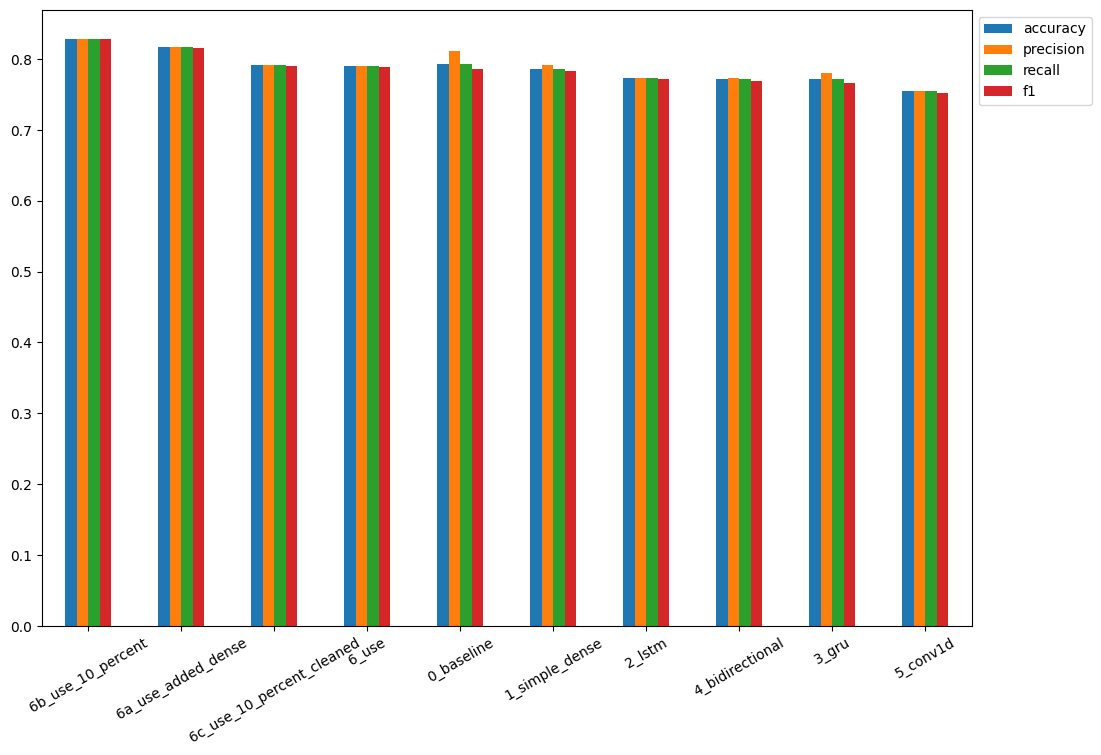
# Load TensorBoard
%load_ext tensorboard
%tensorboard --logdir './tensorboad/'
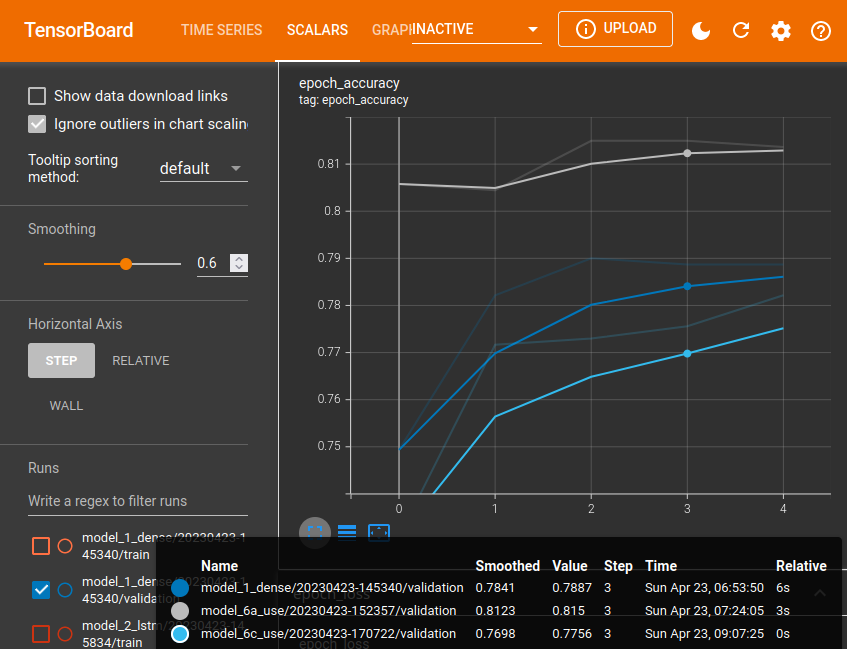
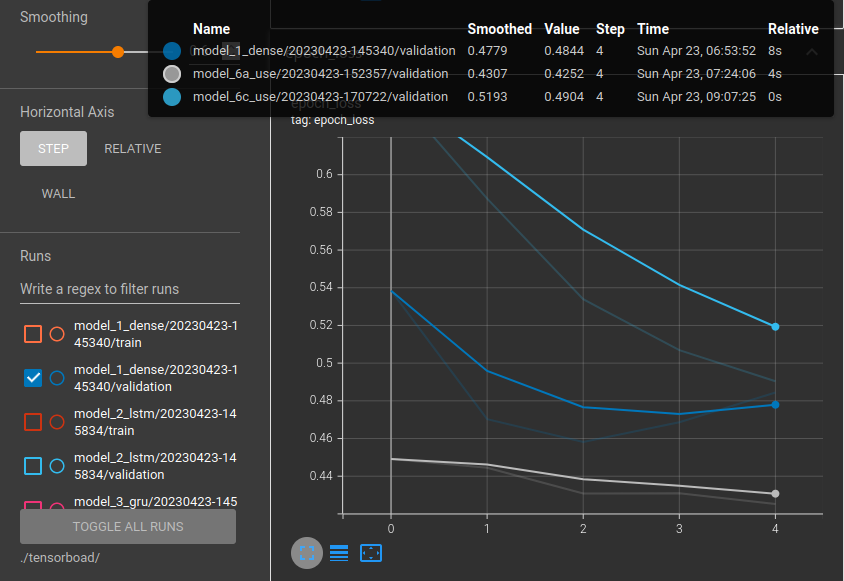
Saving & Loading Trained Model
HDF5 Format (Higher Compatibility to 3rd Parties)
# save best performing model to HDF5 format
model_6a.save('./models/6a_use_added_dense.h5')
# restore model with custom TF Hub layer (only HDF5 format)
# restoring requires import tensorflow_hub as hub
loaded_model_6a = tf.keras.models.load_model(
'./models/6a_use_added_dense.h5',
custom_objects={'KerasLayer': hub.KerasLayer}
)
# verify loaded model
loaded_model_6a.evaluate(val_tweets, val_labels) == model_6a.evaluate(val_tweets, val_labels)
# True
Saved Model Format (Tensorflow Default)
# save best performing model to saved_model format
model_6a.save('./models/6a_use_added_dense')
loaded_model_6a_saved_model = tf.keras.models.load_model(
'./models/6a_use_added_dense',
)
# verify loaded model
loaded_model_6a_saved_model.evaluate(val_tweets, val_labels) == model_6a.evaluate(val_tweets, val_labels)
# True
Best Model Evaluation
# find most wrong predictions
## create dataframe with validation tweets, labels and model predictions
loaded_model_pred_probs = tf.squeeze(loaded_model_6a_saved_model.predict(val_tweets))
loaded_model_preds = tf.round(loaded_model_preds)
print(loaded_model_preds[:5])
# [0. 1. 1. 0. 1.]
pred_df = pd.DataFrame({
"text": val_tweets,
"target": val_labels,
"pred": loaded_model_preds,
"pred_prob": loaded_model_pred_probs
})
pred_df
| text | target | pred | pred_prob | |
|---|---|---|---|---|
| 0 | DFR EP016 Monthly Meltdown - On Dnbheaven 2015... | 0 | 0.0 | 0.191866 |
| 1 | FedEx no longer to transport bioterror germs i... | 0 | 1.0 | 0.793415 |
| 2 | Gunmen kill four in El Salvador bus attack: Su... | 1 | 1.0 | 0.992559 |
| 3 | @camilacabello97 Internally and externally scr... | 1 | 0.0 | 0.255227 |
| 4 | Radiation emergency #preparedness starts with ... | 1 | 1.0 | 0.722030 |
| ... | ||||
| 757 | That's the ultimate road to destruction | 0 | 0.0 | 0.141685 |
| 758 | @SetZorah dad why dont you claim me that mean ... | 0 | 0.0 | 0.111817 |
| 759 | FedEx will no longer transport bioterror patho... | 0 | 1.0 | 0.898317 |
| 760 | Crack in the path where I wiped out this morni... | 0 | 1.0 | 0.671607 |
| 761 | I liked a @YouTube video from @dannyonpc http:... | 0 | 0.0 | 0.127992 |
# create another datframe that only contains wrong predictions
most_wrong = pred_df[pred_df['target'] != pred_df['pred']].sort_values(
'pred_prob',
ascending=False
)
most_wrong
| text | target | pred | pred_prob | |
|---|---|---|---|---|
| 31 | ? High Skies - Burning Buildings ? http://t.co... | 0 | 1.0 | 0.936771 |
| 628 | @noah_anyname That's where the concentration c... | 0 | 1.0 | 0.907564 |
| 759 | FedEx will no longer transport bioterror patho... | 0 | 1.0 | 0.898317 |
| 251 | @AshGhebranious civil rights continued in the ... | 0 | 1.0 | 0.854326 |
| 49 | @madonnamking RSPCA site multiple 7 story high... | 0 | 1.0 | 0.853781 |
| ... | ||||
| 233 | I get to smoke my shit in peace | 1 | 0.0 | 0.052748 |
| 411 | @SoonerMagic_ I mean I'm a fan but I don't nee... | 1 | 0.0 | 0.046553 |
| 244 | Reddit Will Now QuarantineÛ_ http://t.co/pkUA... | 1 | 0.0 | 0.044474 |
| 23 | Ron & Fez - Dave's High School Crush https... | 1 | 0.0 | 0.040853 |
| 38 | Why are you deluged with low self-image? Take ... | 1 | 0.0 | 0.040229 |
False Positives
for row in most_wrong[:10].itertuples():
_, text, target, pred, pred_prob = row
print(f"Target: {target}, Pred: {pred}, Probability: {pred_prob}")
print(f"Tweet: {text}")
print("----\n")
Target: 0, Pred: 1.0, Probability: 0.936771035194397
Tweet: ? High Skies - Burning Buildings ? http://t.co/uVq41i3Kx2 #nowplaying
----
Target: 0, Pred: 1.0, Probability: 0.9075638055801392
Tweet: @noah_anyname That's where the concentration camps and mass murder come in.
EVERY. FUCKING. TIME.
----
Target: 0, Pred: 1.0, Probability: 0.8983168601989746
Tweet: FedEx will no longer transport bioterror pathogens in wake of anthrax lab mishaps http://t.co/lHpgxc4b8J
----
Target: 0, Pred: 1.0, Probability: 0.8543258309364319
Tweet: @AshGhebranious civil rights continued in the 60s. And what about trans-generational trauma? if anything we should listen to the Americans.
----
Target: 0, Pred: 1.0, Probability: 0.8537805676460266
Tweet: @madonnamking RSPCA site multiple 7 story high rise buildings next to low density character residential in an area that floods
----
Target: 0, Pred: 1.0, Probability: 0.8336963057518005
Tweet: [55436] 1950 LIONEL TRAINS SMOKE LOCOMOTIVES WITH MAGNE-TRACTION INSTRUCTIONS http://t.co/xEZBs3sq0y http://t.co/C2x0QoKGlY
----
Target: 0, Pred: 1.0, Probability: 0.833143413066864
Tweet: Ashes 2015: AustraliaÛªs collapse at Trent Bridge among worst in history: England bundled out Australia for 60 ... http://t.co/t5TrhjUAU0
----
Target: 0, Pred: 1.0, Probability: 0.8305423855781555
Tweet: @SonofLiberty357 all illuminated by the brightly burning buildings all around the town!
----
Target: 0, Pred: 1.0, Probability: 0.8277301788330078
Tweet: Deaths 3 http://t.co/nApviyGKYK
----
Target: 0, Pred: 1.0, Probability: 0.8111591935157776
Tweet: The Sound of Arson
----
False Negatives
for row in most_wrong[-10:].itertuples():
_, text, target, pred, pred_prob = row
print(f"Target: {target}, Pred: {pred}, Probability: {pred_prob}")
print(f"Tweet: {text}")
print("----\n")
Target: 1, Pred: 0.0, Probability: 0.07530134916305542
Tweet: going to redo my nails and watch behind the scenes of desolation of smaug ayyy
----
Target: 1, Pred: 0.0, Probability: 0.07096730172634125
Tweet: @DavidVonderhaar At least you were sincere ??
----
Target: 1, Pred: 0.0, Probability: 0.06341199576854706
Tweet: Lucas Duda is Ghost Rider. Not the Nic Cage version but an actual 'engulfed in flames' badass. #Mets
----
Target: 1, Pred: 0.0, Probability: 0.06147787347435951
Tweet: You can never escape me. Bullets don't harm me. Nothing harms me. But I know pain. I know pain. Sometimes I share it. With someone like you.
----
Target: 1, Pred: 0.0, Probability: 0.05444430932402611
Tweet: @willienelson We need help! Horses will die!Please RT & sign petition!Take a stand & be a voice for them! #gilbert23 https://t.co/e8dl1lNCVu
----
Target: 1, Pred: 0.0, Probability: 0.0527476891875267
Tweet: I get to smoke my shit in peace
----
Target: 1, Pred: 0.0, Probability: 0.04655275493860245
Tweet: @SoonerMagic_ I mean I'm a fan but I don't need a girl sounding off like a damn siren
----
Target: 1, Pred: 0.0, Probability: 0.04447368532419205
Tweet: Reddit Will Now QuarantineÛ_ http://t.co/pkUAMXw6pm #onlinecommunities #reddit #amageddon #freespeech #Business http://t.co/PAWvNJ4sAP
----
Target: 1, Pred: 0.0, Probability: 0.04085317254066467
Tweet: Ron & Fez - Dave's High School Crush https://t.co/aN3W16c8F6 via @YouTube
----
Target: 1, Pred: 0.0, Probability: 0.0402291864156723
Tweet: Why are you deluged with low self-image? Take the quiz: http://t.co/XsPqdOrIqj http://t.co/CQYvFR4UCy
----
Test Dataset Predictions
# get the test dataset and randomize
test_df_shuffle = test_df.sample(frac=1, random_state=SEED)
test_df_shuffle.head(5)
| id | keyword | location | text | |
|---|---|---|---|---|
| 2406 | 8051 | refugees | NaN | Refugees as citizens - The Hindu http://t.co/G... |
| 134 | 425 | apocalypse | Currently Somewhere On Earth | @5SOStag honestly he could say an apocalypse i... |
| 411 | 1330 | blown%20up | Scout Team | If you bored as shit don't nobody fuck wit you... |
| 203 | 663 | attack | NaN | @RealTwanBrown Yesterday I Had A Heat Attack ?... |
| 889 | 2930 | danger | Leeds | The Devil Wears Prada is still one of my favou... |
test_tweets = test_df_shuffle['text']
test_tweets = np.array(test_tweets.values.tolist())
loaded_model_pred_probs_test = tf.squeeze(loaded_model_6a_saved_model.predict(test_tweets))
loaded_model_preds_test = tf.round(loaded_model_pred_probs_test)
pred_test_df = pd.DataFrame({
"text": test_tweets,
"pred": loaded_model_preds_test,
"pred_prob": loaded_model_pred_probs_test
})
pred_test_df
| text | pred | pred_prob | |
|---|---|---|---|
| 0 | Refugees as citizens - The Hindu http://t.co/G... | 1.0 | 0.717548 |
| 1 | @5SOStag honestly he could say an apocalypse i... | 0.0 | 0.093809 |
| 2 | If you bored as shit don't nobody fuck wit you... | 0.0 | 0.082749 |
| 3 | @RealTwanBrown Yesterday I Had A Heat Attack ?... | 0.0 | 0.097784 |
| 4 | The Devil Wears Prada is still one of my favou... | 0.0 | 0.028455 |
| ... | |||
| 3258 | Free Kindle Book - Aug 3-7 - Thriller - Desola... | 0.0 | 0.080420 |
| 3259 | HitchBot travels Europe and greeted with open ... | 1.0 | 0.603396 |
| 3260 | If you told me you was drowning. I would not l... | 0.0 | 0.208108 |
| 3261 | First time for everything! @ Coney Island Cycl... | 1.0 | 0.617582 |
| 3262 | Rocky Fire #cali #SCFD #wildfire #LakeCounty h... | 1.0 | 0.794876 |
# make random prediction on sub-samples of the test dataset
test_samples = random.sample(test_tweets.tolist(), 10)
for test_sample in test_samples:
pred_prob = tf.squeeze(loaded_model_6a_saved_model.predict([test_sample]))
pred = tf.round(pred_prob)
print(f"Pred: {int(pred)}, Probability: {pred_prob}")
print(f"Text: {test_sample}")
print("-------\n")
1/1 [==============================] - 0s 26ms/step
Pred: 0, Probability: 0.15592874586582184
Text: @EllaEMusic_ You should have just simply let on that you had electrocuted yourself while plugging in your phone charger. It works for me...
-------
1/1 [==============================] - 0s 25ms/step
Pred: 1, Probability: 0.5131102800369263
Text: Evacuation drill at work. The fire doors wouldn't open so i got to smash the emergency release glass #feelingmanly
-------
1/1 [==============================] - 0s 33ms/step
Pred: 1, Probability: 0.9751215577125549
Text: Rare photographs show the nightmare aftermath of #Hiroshima | #NoNukes #Amerikkka #WhiteTerrorism #Nuclear #Disaster http://t.co/8tWLAKdaBf
-------
1/1 [==============================] - 0s 28ms/step
Pred: 1, Probability: 0.676400899887085
Text: kayaking about killed us so mom and grandma came to the rescue.
-------
1/1 [==============================] - 0s 26ms/step
Pred: 1, Probability: 0.9690964818000793
Text: Pasco officials impressed by drone video showing floods: Drone videos have given an up-close view of flooded areasÛ_ http://t.co/PrUunEDids
-------
1/1 [==============================] - 0s 29ms/step
Pred: 0, Probability: 0.07793092727661133
Text: just trying to smoke and get Taco Bell
-------
1/1 [==============================] - 0s 26ms/step
Pred: 1, Probability: 0.9799614548683167
Text: RT AbbsWinston: #Zionist #Terrorist kidnapped 15 #Palestinians in overnight terror on Palestinian Villages Û_ http://t.co/J5mKcbKcov
-------
1/1 [==============================] - 0s 24ms/step
Pred: 1, Probability: 0.8005449771881104
Text: ME: gun shot wounds 3 4 6 7 'rapidly lethal' would have killed in 30-60 seconds or few minutes max. #kerricktrial
-------
1/1 [==============================] - 0s 24ms/step
Pred: 1, Probability: 0.9902410507202148
Text: Three Israeli soldiers wounded in West Bank terrorist attack - Haaretz http://t.co/Mwd1iPMoWT #world
-------
1/1 [==============================] - 0s 29ms/step
Pred: 0, Probability: 0.03447313234210014
Text: @_Souuul * gains super powers im now lava girl throws you ina chest wrapped in chains & sinks you down the the bottom of the ocean*
-------
Speed/Score Tradeoff
def time_to_prediction(model, samples):
start_time = time.perf_counter()
model.predict(samples)
end_time = time.perf_counter()
time_to_prediction = end_time - start_time
prediction_time_weighted = time_to_prediction / len(samples)
return time_to_prediction, prediction_time_weighted
model_6_time_to_prediction, model_6_prediction_time_weighted = time_to_prediction(
model = loaded_model_6a_saved_model,
samples = test_tweets
)
print(model_6_time_to_prediction, model_6_prediction_time_weighted)
# 0.4922969689941965 0.0001508725004579211
model_0_time_to_prediction, model_0_prediction_time_weighted = time_to_prediction(
model = model_0,
samples = test_tweets
)
print(model_0_time_to_prediction, model_0_prediction_time_weighted)
# 0.05065811199892778 1.5525011338929752e-05
TimeToPrediction = [model_6_time_to_prediction, model_0_time_to_prediction]
TimeToPredictionWeighted = [model_6_prediction_time_weighted, model_0_prediction_time_weighted]
index = ['Model 6', 'Model 0']
prediction_times_df = pd.DataFrame({
'TimeToPrediction': TimeToPrediction,
'TimeToPrediction (weighted)': TimeToPredictionWeighted
}, index=index)
prediction_times_df.plot(
kind='bar',
rot=0,
subplots=True,
figsize=(12,8)
)
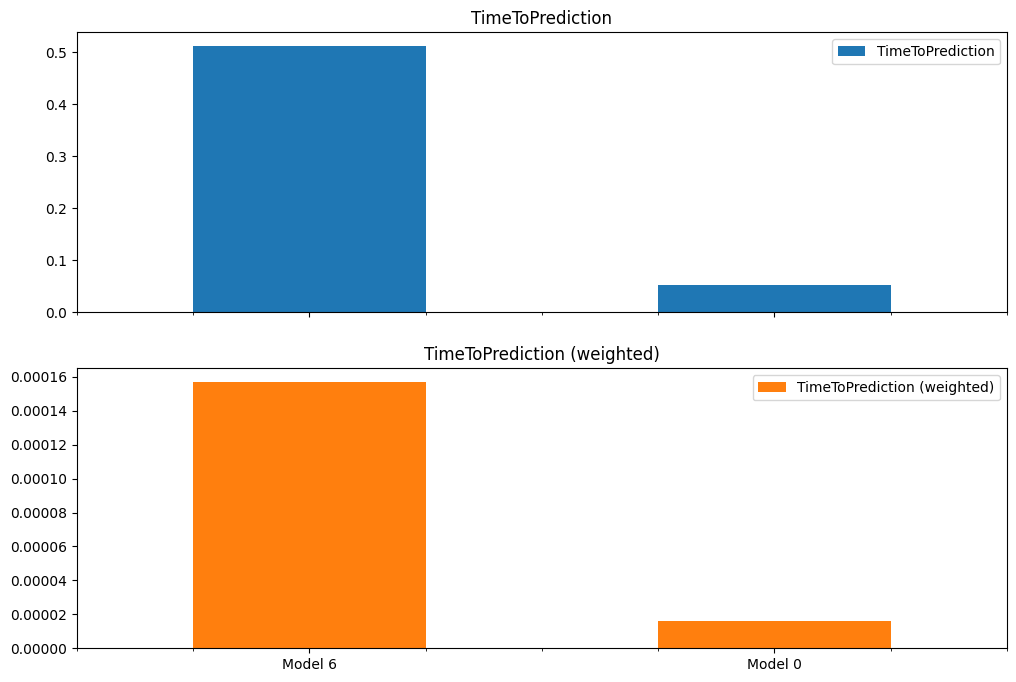
Comparing the Performance of all Models
model_1_time_to_prediction, model_1_prediction_time_weighted = time_to_prediction(
model = model_1,
samples = test_tweets
)
model_2_time_to_prediction, model_2_prediction_time_weighted = time_to_prediction(
model = model_2,
samples = test_tweets
)
model_3_time_to_prediction, model_3_prediction_time_weighted = time_to_prediction(
model = model_3,
samples = test_tweets
)
model_4_time_to_prediction, model_4_prediction_time_weighted = time_to_prediction(
model = model_4,
samples = test_tweets
)
model_5_time_to_prediction, model_5_prediction_time_weighted = time_to_prediction(
model = model_5,
samples = test_tweets
)
model_6_time_to_prediction, model_6_prediction_time_weighted = time_to_prediction(
model = model_6,
samples = test_tweets
)
model_6a_time_to_prediction, model_6a_prediction_time_weighted = time_to_prediction(
model = model_6a,
samples = test_tweets
)
model_6b_time_to_prediction, model_6b_prediction_time_weighted = time_to_prediction(
model = model_6b,
samples = test_tweets
)
model_6c_time_to_prediction, model_6c_prediction_time_weighted = time_to_prediction(
model = model_6c,
samples = test_tweets
)
plt.figure(figsize=(12, 8))
plt.scatter(model_6c_time_to_prediction, model_6c_metrics['f1'], label='Pre-trained USE (10%)')
plt.scatter(model_6b_time_to_prediction, model_6b_metrics['f1'], label='Pre-trained USE (10% / data leakage)')
plt.scatter(model_6a_time_to_prediction, model_6a_metrics['f1'], label='Pre-trained USE (added Dense)')
plt.scatter(model_6_time_to_prediction, model_6_metrics['f1'], label='Pre-trained USE')
plt.scatter(model_5_time_to_prediction, model_5_metrics['f1'], label='1D-Convolutional Neural Network (CNN)')
plt.scatter(model_4_time_to_prediction, model_4_metrics['f1'], label='Bidirectional-LSTM model (RNN)')
plt.scatter(model_3_time_to_prediction, model_3_metrics['f1'], label='GRU model (RNN)')
plt.scatter(model_2_time_to_prediction, model_2_metrics['f1'], label='LSTM model (RNN)')
plt.scatter(model_1_time_to_prediction, model_1_metrics['f1'], label='Feed-forward neural network (dense model)')
plt.scatter(model_0_time_to_prediction, baseline_metrics['f1'], label='Naive Bayes (baseline)')
plt.legend()
plt.title("F1-Score vs Time to Prediction")
plt.xlabel('Time to Prediction')
plt.ylabel('F1-Score')
